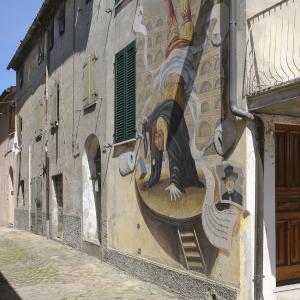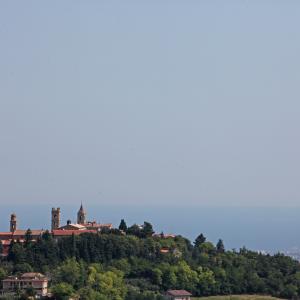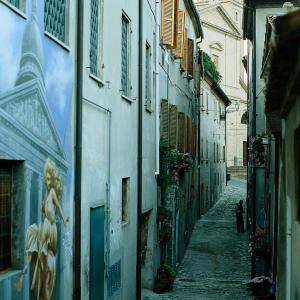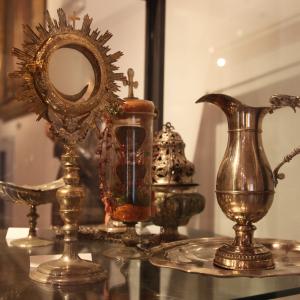Saludecio, a journey through history and an open-air art gallery
Saludecio, the painted village: a day among ancient walls, noble palaces and open-air murals.
Duration: 24 hours
Recommended for family, friends, couples.
Saludecio is one of those villages best discovered on foot, letting the alleys and colours guide you. A town overlooking the Conca Valley that holds together the Middle Ages, noble palaces and a true open-air art gallery.
First stop Porta Marina
Enter the town passing under Porta Marina, a 14th-century tower built during the Malatesta era. It is the main entrance to the village, with its 16th-century coat of arms towering above and immediately telling of Saludecio's fortified past.
Second stop Piazza Santo Amato Ronconi
A few steps and you arrive in Piazza Santo Amato Ronconi: on one side the church of San Biagio, imposing and scenic; on the other the Palazzo Comunale, carved out of the ancient Malatesta fortress, which in the former prisons houses the Risorgimento exhibition-museum dedicated to Giuseppe Garibaldi, with unique relics collected from all over the world.
Third stop Civic Tower and Saludecio and Holy Amato Museum
The route continues to the 14th-century Civic Tower, now a venue for temporary exhibitions, and the Museum of Saludecio and the Beloved Saint, a treasure trove of sacred art that houses, among others, the "Procession of the Blessed Sacrament" (1628) and the "Ecstasy of St. Sisto" by Guido Cagnacci.
Fourth stop Via Roma and the noble palaces
Along Via Roma, Saludecio shows its most elegant side: 16th- and 19th-century palazzi follow one after the other. Palazzo Albini stands out, with its Urbino-style courtyard that welcomed General Garibaldi for a night in 1859, followed by the historic residences of Beata Elisabetta Renzi, Palazzo Magi, Palazzo Zandri, Palazzo Albini-Suali and Palazzo Albini-Elisei.
Fifth stop Porta Montanara and the 19th-century murals
On the opposite side of the village, Porta Montanara recalls the defensive function towards the hinterland, while the 51 murals scattered among the alleys and small squares transform Saludecio into an en plein air museum dedicated to the 19th century, which has earned it the title of 'City of Painted Walls'.
Tips for true professionals
- Arrive late in the morning: take a tour of the village, visit the museum and tower, then stop at an osteria for lunch and resume the mural tour in the afternoon.
- Bring a list of 'must-see' murals with you and play at finding them one by one: this is the best way to explore even the most hidden alleys.
- If you love photos, aim for the golden hour: the colours of the 19th century painted on the walls with the warm light of sunset make for a simply perfect roll of film.



